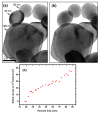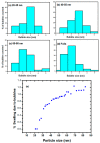Enhanced Radiation Tolerance of Tungsten Nanoparticles to He Ion Irradiation
- PMID: 30558254
- PMCID: PMC6316147
- DOI: 10.3390/nano8121052
Enhanced Radiation Tolerance of Tungsten Nanoparticles to He Ion Irradiation
Abstract
Materials exposed to plasmas in magnetic confinement nuclear reactors will accumulate radiation-induced defects and energetically implanted gas atoms (from the plasma and transmutations), of which insoluble helium (He) is likely to be the most problematic. The large surface-area-to-volume ratio exhibited by nanoporous materials provides an unsaturable sink with the potential to continuously remove both point defects and He. This property enhances the possibilities for these materials to be tailored for high radiation-damage resistance. In order to explore the potential effect of this on the individual ligaments of nanoporous materials, we present results on the response of tungsten (W) nanoparticles (NPs) to 15 keV He ion irradiation. Tungsten foils and various sizes of NPs were ion irradiated concurrently and imaged in-situ via transmission electron microscopy at 750 °C. Helium bubbles were not observed in NPs with diameters less than 20 nm but did form in larger NPs and the foils. No dislocation loops or black spot damage were observed in any NPs up to 100 nm in diameter but were found to accumulate in the W foils. These results indicate that a nanoporous material, particularly one made up of ligaments with characteristic dimensions of 30 nm or less, is likely to exhibit significant resistance to He accumulation and structural damage and, therefore, be highly tolerant to radiation.
Keywords: helium bubbles; in-situ TEM; nanoporous materials; plasma-facing materials; radiation tolerance; tungsten nanoparticles.
Conflict of interest statement
The authors declare no conflict of interest. The funders had no role in the design of the study; in the collection, analyses, or interpretation of data; in the writing of the manuscript, or in the decision to publish the results”.
Figures







References
-
- Ongena J., Koch R., Wolf R., Zohm H. Magnetic-confinement fusion. Nat. Phys. 2016;12:398–410. doi: 10.1038/nphys3745. - DOI
-
- Shimada M., Campbell D.J., Mukhovatov V., Fujiwara M., Kirneva N., Lackner K., Nagami M., Pustovitov V.D., Uckan N., Wesley J., et al. Progress in the ITER physics basis chapter 1: Overview and summary. Nucl. Fusion. 2007;47 doi: 10.1088/0029-5515/47/6/S01. - DOI
-
- Tokunaga K., Baldwin M.J., Doerner R.P., Noda N., Kubota Y., Yoshida N., Sogabe T., Kato T., Schedler B. Blister formation and deuterium retention on tungsten exposed to low energy and high flux deuterium plasma. J. Nucl. Mater. 2005;337–339:887–891. doi: 10.1016/j.jnucmat.2004.10.137. - DOI
-
- Hasegawa A., Fukuda M., Yabuuchi K., Nogami S. Neutron irradiation effects on the microstructural development of tungsten and tungsten alloys. J. Nucl. Mater. 2016;471:175–183. doi: 10.1016/j.jnucmat.2015.10.047. - DOI
-
- Ueda Y., Coenen J.W., De Temmerman G., Doerner R.P., Linke J., Philipps V., Tsitrone E. Research status and issues of tungsten plasma facing materials for ITER and beyond. Fusion Eng. Des. 2014;89:901–906. doi: 10.1016/j.fusengdes.2014.02.078. - DOI
Grants and funding
LinkOut - more resources
Full Text Sources

